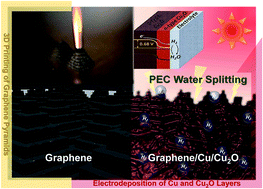3D-printed Cu2O photoelectrodes for photoelectrochemical water splitting†
Abstract
Photoelectrochemical (PEC) water splitting is an alternative to fossil fuel combustion involving the generation of renewable hydrogen without environmental pollution or greenhouse gas emissions. Cuprous oxide (Cu2O) is a promising semiconducting material for the simple reduction of hydrogen from water, in which the conduction band edge is slightly negative compared to the water reduction potential. However, the solar-to-hydrogen conversion efficiency of Cu2O is lower than the theoretical value due to a short carrier-diffusion length under the effective light absorption depth. Thus, increasing light absorption in the electrode–electrolyte interfacial layer of a Cu2O photoelectrode can enhance PEC performance. In this study, a Cu2O 3D photoelectrode comprised of pyramid arrays was fabricated using a two-step method involving direct-ink-writing of graphene structures. This was followed by the electrodeposition of a Cu current-collecting layer and a p–n homojunction Cu2O photocatalyst layer onto the printed structures. The performance for PEC water splitting was enhanced by increasing the total light absorption area (Aa) of the photoelectrode via controlling the electrode topography. The 3D photoelectrode (Aa = 3.2 cm2) printed on the substrate area of 1.0 cm2 exhibited a photocurrent (Iph) of −3.01 mA at 0.02 V (vs. RHE), which is approximately three times higher than that of a planar photoelectrode with an Aa = 1.0 cm2 (Iph = −0.91 mA). Our 3D printing strategy provides a flexible approach for the design and the fabrication of highly efficient PEC photoelectrodes.

- This article is part of the themed collections: International Open Access Week 2020 and Photocatalysis and Photoelectrochemistry


 Please wait while we load your content...
Please wait while we load your content...